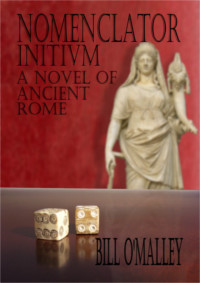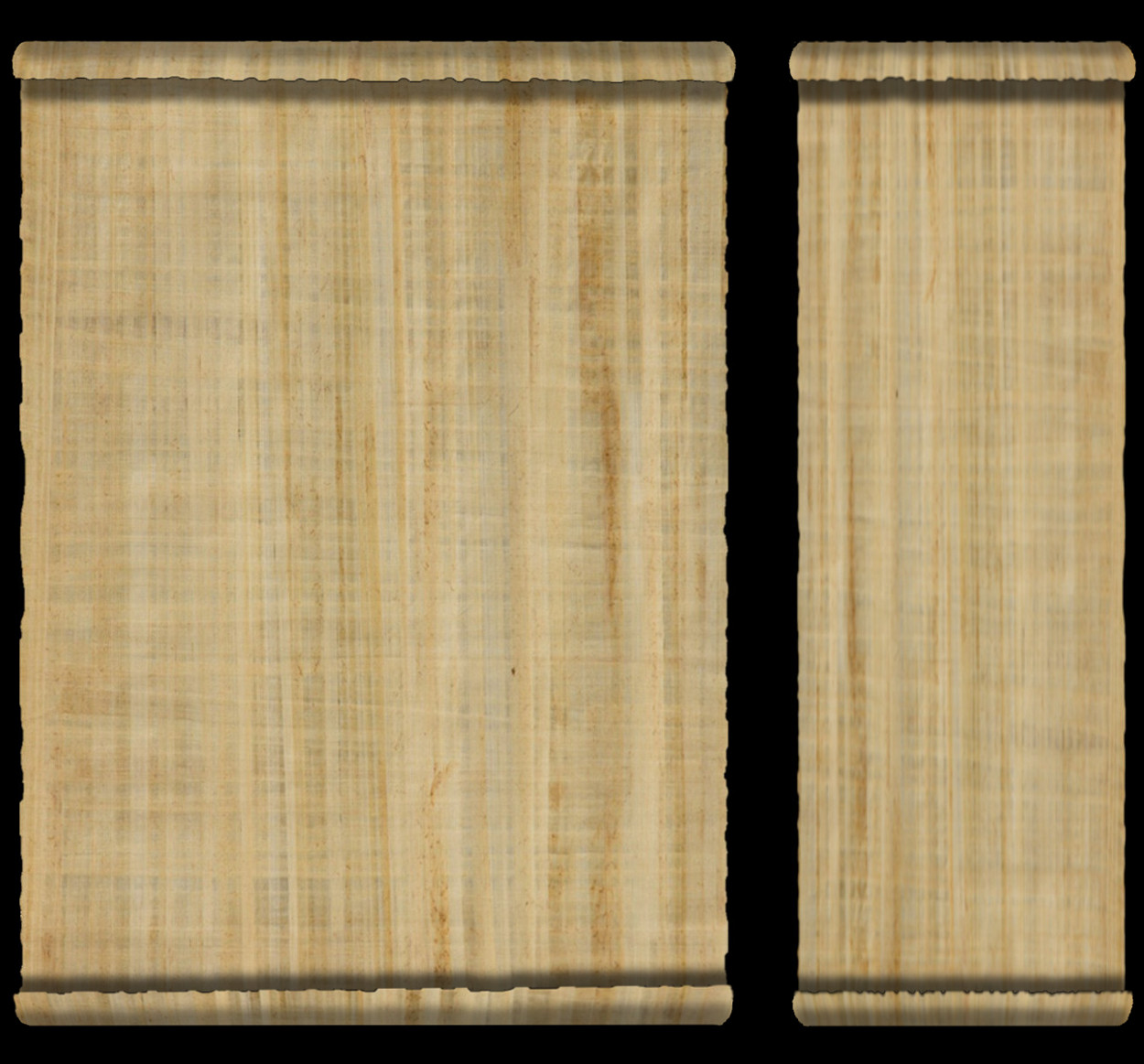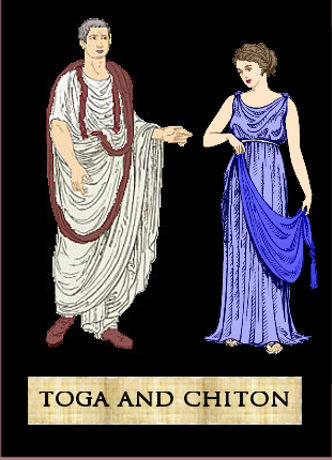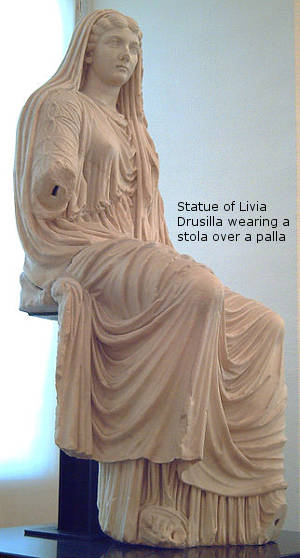


Ancient Roman Clothing
Popular culture has promoted the idea that the ancient Romans were flamboyant in their dress, but for most of Rome’s history this was not the case. There was little variety in the types of clothing worn by both men and women and, as dyes were expensive, only the wealthier citizens could afford colorful clothing.
Men dressed in either a tunica or a toga or both. The tunica, or in English, tunic, was originally a long strip of cloth sewn together at the side with arm holes. This was then tied at the waist with a belt of some sort. The typical tunic was short, stopping just above the knees although longer tunics were known. A later innovation was to add short sleeves to the garment. As a young man, Julius Caesar scandalized Rome by adding longer sleeves with fringes to his tunic. The social status of a citizen was indicated by the width of purple stripes on the tunic he wore. The original purple used in Roman clothing was somewhat redder than what we would call purple. Slaves and plebeians wore a tunic with no stripes. Equites wore what was termed Angusticlavia or narrow striped tunics. Roman senators and magistrates wore the broader Laticlavus stripes on their tunics.
The toga was a large wrap of cloth that was considered more formal attire for a man, but only Roman citizens were allowed to wear a toga. The largest of togas could be eight or nine yards of fabric. A toga was most often worn over a tunic but sometimes men would wear it without the tunic. The toga virilis was a plain off white toga with no ornamentation. This was the toga worn by any adult male. The toga praetexta was an off white toga with a broad purple stripe along its border. This was worn only by senators and Curule Magistrates such as consuls, praetors, and aediles. Oddly though, the toga praetexta was also worn by boys who had not yet come of age. A third type of toga was the toga candida. This was a toga virilis that was whitened with naturally occurring bleaches derived from plants and white chalk. This toga was worn by a candidate for office and was used to not only indicate his pure intentions, but also made him stand out in a crowd. The fourth type of toga was the toga pulla. This toga was artificially darkened and worn during periods of mourning. The toga picta was the final type of toga. This toga was dyed purple and embroidered with gold thread. This toga was only worn by a conquering general during his triumph, the parade designed to celebrate the general’s great success. The only Roman women who wore togas were prostitutes.
The two most common fabrics were wool and linen, but other less expensive fabrics may have been used by poor citizens and slaves. Silk was known in Rome but it was quite expensive as it had to be imported from the east through India and North Africa. The people of East Asia carefully guarded the secret of how the delicate fine thread of silk was produced and it was unknown to Romans throughout most of history. Silk garments because of their expense were only worn by the wealthiest of Romans.

Popular culture has promoted the idea that the ancient Romans were flamboyant in their dress, but for most of Rome’s history this was not the case. There was little variety in the types of clothing worn by both men and women and, as dyes were expensive, only the wealthier citizens could afford colorful clothing.
Men dressed in either a tunica or a toga or both. The tunica, or in English, tunic, was originally a long strip of cloth sewn together at the side with arm holes. This was then tied at the waist with a belt of some sort. The typical tunic was short, stopping just above the knees although longer tunics were known. A later innovation was to add short sleeves to the garment. As a young man, Julius Caesar scandalized Rome by adding longer sleeves with fringes to his tunic. The social status of a citizen was indicated by the width of purple stripes on the tunic he wore. The original purple used in Roman clothing was somewhat redder than what we would call purple. Slaves and plebeians wore a tunic with no stripes. Equites wore what was termed Angusticlavia or narrow striped tunics. Roman senators and magistrates wore the broader Laticlavus stripes on their tunics.
The toga was a large wrap of cloth that was considered more formal attire for a man, but only Roman citizens were allowed to wear a toga. The largest of togas could be eight or nine yards of fabric. A toga was most often worn over a tunic but sometimes men would wear it without the tunic. The toga virilis was a plain off white toga with no ornamentation. This was the toga worn by any adult male. The toga praetexta was an off white toga with a broad purple stripe along its border. This was worn only by senators and Curule Magistrates such as consuls, praetors, and aediles. Oddly though, the toga praetexta was also worn by boys who had not yet come of age. A third type of toga was the toga candida. This was a toga virilis that was whitened with naturally occurring bleaches derived from plants and white chalk. This toga was worn by a candidate for office and was used to not only indicate his pure intentions, but also made him stand out in a crowd. The fourth type of toga was the toga pulla. This toga was artificially darkened and worn during periods of mourning. The toga picta was the final type of toga. This toga was dyed purple and embroidered with gold thread. This toga was only worn by a conquering general during his triumph, the parade designed to celebrate the general’s great success. The only Roman women who wore togas were prostitutes.
The two most common fabrics were wool and linen, but other less expensive fabrics may have been used by poor citizens and slaves. Silk was known in Rome but it was quite expensive as it had to be imported from the east through India and North Africa. The people of East Asia carefully guarded the secret of how the delicate fine thread of silk was produced and it was unknown to Romans throughout most of history. Silk garments because of their expense were only worn by the wealthiest of Romans.
Women’s dresses reached down to their ankles but there were only three commonly worn styles for women. There was the peplos, which was sewn together to form a long tube of cloth. The top part of the tube was folded down so that it draped below the waist. The top edge of the tube was then pinned or tied over the shoulders leaving holes for the arms. The part that was hanging down past the waist was then gathered around the waist with a belt or strip of fabric.
The second type of dress was the chiton. This dress had sleeves and was made from two wide pieces of cloth sewn together. This dress was put on over the woman’s head and then styled with buttons or pins to create different forms. Sometimes a belt or ribbon was added to cinch the dress at the hips, waist, or under the breasts. In general, women wore more colorful clothes than men.

Married women were frequently wore a stola. A stola was pleated and draped down to the ankles. The traditional stola was sleeveless, but sleeved styles were sometimes worn. The stola was generally pinned at the shoulder and was typically bound by two belts or ribbons. One ribbon was tied under the breasts and the second was at the waist, creating numerous folds.
The pulla was a type of shawl or wrap that women wore over their dresses, especially in cooler weather.
There were two common types of shoes. The first was the soleae which was a full shoe that completely wrapped the foot and sometimes the ankle. The second was the calceus which was a sandal. Shoes were made available in a variety of materials and colors, but leather was the most common.
These links are being provided as a convenience and for informational purposes only; they do not constitute an endorsement or an approval by Nomenclator Books or Bill O'Malley of any of the products, services or opinions of the corporation or organization or individual. Nomenclator Books and Bill O'Malley bears no responsibility for the accuracy, legality or content of the external site or for that of subsequent links. Contact the external site for answers to questions regarding its content.



















